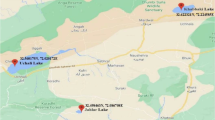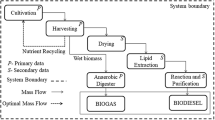Abstract
Microalgae hold a promising potential for generating third-generation biofuel as well as for biological carbon sequestration. However, translation of algal technology to field scale is often hindered by a lack of appropriate data and economic challenges. Pertaining to these issues, a pre-estimate of the site-specific productivity of microalgae at realistic scenario is necessary. Five potential sites (Rourkela, Sambalpur, Bhubaneswar, Gopalpur and Balasore) in the Odisha state of India were chosen for predicting the average biomass, lipid productivity and carbon dioxide (CO2) capture capacity of microalgae. Meteorological data averaged over 21 years (Jan’ 1985–Dec’ 2005) were fed into the biophysical empirical equations for estimating the biomass and lipid productivity of microalgae along with the CO2 sequestration capacity. Maximum average biomass and lipid productivity was projected for Sambalpur, corresponding to an aerial value of 63.03 g/m2/day and 21.89 ml/m2/day, respectively, in the month of April with CO2 sequestration potential of 17.87 g/m2/day. Such preliminary site-specific theoretical estimates would facilitate policy making for realizing the potential of large-scale algal cultivation.





Similar content being viewed by others
Abbreviations
- \(E_{\text{Solar}}\) :
-
Full-spectrum solar energy that accounts to the total amount of incident solar insolation
- PAR:
-
Photosynthetically active radiation, which relates to the amount of solar radiation (400–700 nm) used for photosynthesis
- c :
-
Velocity of light (2.998e8 m/s)
- h :
-
Plank’s constant (6.63e−34 J/s)
- \(\lambda\) :
-
Wavelength of light (nm)
- \(E_{\text{Photons}}\) :
-
Energy of photons (kJ/mol)
- HHV:
-
Higher heating value of microalgae (36.6 kJ/mol of photon)
- \(n_{\text{photon}}\) :
-
Number of photons required to convert 1 mol of CO2 to biomass
- Energy of PAR:
-
Amount of energy (kJ/mol of photon) corresponding to PAR (400–700 nm)
- \(\eta_{\text{Transmission}}\) :
-
Amount of light transmitted onto the surface of microalgae
- α :
-
Coefficient of light absorption by microalgae
- \(\eta_{\text{Capture}}\) :
-
Amount of incident solar energy captured by microalgae and converted into biomass
- \(\eta_{\text{Photosynthesis}}\) :
-
Photon conversion efficiency, which denotes the maximum amount of light energy that can be converted into biomass and is constant for all microalgal species
- \(\eta_{{{\text{Photon}}\;{\text{utilisation}}}}\) :
-
Capacity of utilization of the available photon energy by microalgae
- r :
-
Fraction of energy used by microalgae for respiration
- \(I_{\text{S}}\) :
-
Light saturation in the process of photosynthesis (µmoles/m2 s)
- \(I_{\text{I}}\) :
-
Incident light used in photosynthesis (µmoles/m2 s)
- \(f_{\text{L}}\) :
-
Fraction of lipids
- \(f_{\text{P}}\) :
-
Fraction of proteins
- \(f_{\text{C}}\) :
-
Fraction of carbohydrates
- \(E_{\text{L}}\) :
-
Energy content of lipids (kJ/g)
- \(E_{\text{P}}\) :
-
Energy content of proteins (kJ/g)
- \(E_{\text{C}}\) :
-
Energy content of carbohydrates (kJ/g)
- \(E_{\text{Microalgae}}\) :
-
Total energy stored in microalgae (MJ/kg)
- \({\text{MB}}_{{ ( {\text{daily)}}}}\) :
-
Daily microalgal biomass productivity (g/m2/day)
- \({\text{ML}}_{{ ( {\text{daily)}}}}\) :
-
Daily microalgal lipid productivity (ml/m2/day)
- \(\rho_{\text{L}}\) :
-
Density of lipids (0.85 kg/l)
- \(M_{{{\text{CO}}_{ 2} }}\) :
-
Molecular mass of CO2 (44 g/mol)
- \(M_{\text{Biomass}}\) :
-
Molecular mass of microalgae (g)
- K :
-
Rate constant of CO2 captured (1.89)
- Total CO2 :
-
Total amount of CO2 sequestered (g/m2/day)
References
B. Behera, A. Acharya, I.A. Gargey, N. Aly, P. Balasubramanian, Bioprocess engineering principles of microalgal cultivation for sustainable biofuel production. Bioresour. Technol. Rep. 5, 297–316 (2019)
S. Rangabhashiyam, B. Behera, N. Aly, P. Balasubramanian, Biodiesel from microalgae as a promising strategy for renewable bioenergy production—a review. J. Env. Biotech. Res. 6(4), 260–269 (2017)
C.Y. Kao, T.Y. Chen, Y.B. Chang, T.W. Chiu, L.H. Lin, C.D. Chen, J.S. Chang, C.S. Lin, Utilization of carbon dioxide in industrial flue gases for the cultivation of microalga Chlorella sp. Bioresour. Technol. 166, 485–493 (2014)
A. Aslam, S.R. Thomas-Hall, T.A. Mughal, P.M. Schenk, Selection and adaptation of microalgae to growth in 100% unfiltered coal-fired flue gas. Bioresour. Technol. 233, 271–283 (2017)
R.R. Pradhan, R.R. Pradhan, S. Das, B. Dubey, A. Dutta, Bioenergy combined with carbon capture potential by microalgae at flue gas-based carbon sequestration plant of NALCO as accelerated carbon sink, Carbon Utilization (Springer, Singapore, 2017), pp. 231–244
C. Zhu, X. Zhai, Y. Xi, J. Wang, F. Kong, Y. Zhao, Z. Chi, Efficient CO2 capture from the air for high microalgal biomass production by a bicarbonate pool. J. CO2 Util. 37, 320–327 (2019)
B. Behera, N. Aly, P. Balasubramanian, Biophysical modeling of microalgal cultivation in open ponds. Ecol. Modell. 388, 61–71 (2018)
B. Behera, N. Aly, M.A. Rajkumar, P. Balasubramanian, Theoretical estimation of the microalgal potential for biofuel production and carbon dioxide sequestration in India, Soft Computing for Problem Solving (Springer, Singapore, 2019), pp. 775–790
K.M. Weyer, D.R. Bush, A. Darzins, B.D. Willson, Theoretical maximum algal oil production. Bioenergy Res. 3, 204–213 (2010)
M.S. Wigmosta, A.M. Coleman, R.J. Skaggs, M.H. Huesemann, L.J. Lane, National microalgae biofuel production potential and resource demand. Water Resour. Res. 47, 1–13 (2011)
K. Sudhakar, M. Premalatha, Theoretical assessment of algal biomass potential for carbon mitigation and biofuel production. Iran. J. Energy Env. 3, 232–240 (2012)
A.M. Asmare, B.A. Demessie, G.S. Murthy, Theoretical estimation the potential of algal biomass for biofuel production and carbon sequestration in Ethiopia. Int. J. Renew Energy Res. 3, 560–570 (2013)
N. Aly, P. Balasubramanian, Effect of geographical coordinates on carbon dioxide sequestration potential by microalgae. Int. J. Environ. Sci. Dev. 8, 147–152 (2017)
A.M. Al Ketife, F. Almomani, E.N. Muftah, S. Judd, A technoeconomic assessment of microalgal culture technology implementation for combined wastewater treatment and CO2 mitigation in the Arabian Gulf. Process. Saf. Environ. 127, 90–102 (2019)
J. Moreno, M.A. Vargas, M.G. Guerrero, Outdoor cultivation of a nitrogen-fixing marine cyanobacterium, Anabaena sp. ATCC 33047. Biomol. Eng. 20, 191–197 (2003)
G. De Bhowmick, G. Subramanian, S. Mishra, R. Sen, Raceway pond cultivation of a marine microalga of Indian origin for biomass and lipid production: a case study. Algal Res. 6, 201–209 (2014)
N. Aly, P. Balasubramanian, Effect of photoinhibition on microalgal growth in open ponds of NIT Rourkela, India. J. Biochem. Technol. 6, 1034–1039 (2016)
N. Aly, R.K. Tarai, P.G. Kale, P. Balasubramanian, Modelling the effect of photoinhibition on microalgal production potential in fixed and trackable photobioreactors in Odisha, India. Curr. Sci. 113, 272–283 (2017)
B. Behera, N. Aly, P. Balasubramanian, Biophysical model and techno-economic assessment of carbon sequestration by microalgal ponds in Indian coal based power plants. J. Clean. Prod. 221, 587–597 (2019)
P.W. Stackhouse, 2015 NASA Surface meteorology and Solar Energy: Interannual Variability. [Online] Available at: https://eosweb.larc.nasa.gov/cgi-bin/sse/interann.cgi?email=skip@larc.nasa.gov
A.E. Lawin, M. Niyongendako, C. Manirakiza, Solar irradiance and temperature variability and projected trends analysis in Burundi. Climate 7, 83 (2019)
Y. Chisti, Biodiesel from microalgae. Biotechnol. Adv. 25(3), 294–306 (2007)
J.A. Gonzalez, J. Calbo, Modelled and measured ratio of PAR to global radiation under cloudless skies. Agric. For. Meteorol. 110, 319–325 (2002)
G. Torzillo, B. Pushparaj, J. Masojidek, A. Vonshak, Biological constraints in algal biotechnology. Biotechnol. Bioprocess. Eng. 8, 338–348 (2003)
T.J. Lundquist, I.C. Woertz, N.W.T. Quinn, J.R. Benemann, A Realistic Technology and Engineering Assessment of Algae Biofuel Production (Energy Biosciences Institute, San Luis Obispo, 2010)
K. Sudhakar, M. Rajesh, M.A. Premalatha, A mathematical model to assess the potential of algal biofuels in India. Energy Source A Recov. Util. Environ. Effects 34, 1114–1120 (2012)
S. Hindersin, M. Leupold, M. Kerner, D. Hanelt, Irradiance optimization of outdoor microalgal cultures using solar tracked photobioreactors. Bioprocess. Biosyst. Eng. 36, 345–355 (2013)
S.H. Baek, S.W. Jung, K. Shin, Effects of temperature and salinity on growth of Thalassiosira pseudonana (Bacillariophyceae) isolated from ballast water. J. Freshw. Ecol. 26, 547–552 (2011)
M.A. Borowitzka, Commercial production of microalgae: ponds, tanks, tubes, and fermenters. J. Biotechnol. 70, 313–321 (1999)
S. Chinnasamy, A. Bhatnagar, R.W. Hunt, K.C. Das, Microalgae cultivation in a wastewater dominated by carpet mill effluents for biofuel applications. Bioresour. Technol. 101, 3097–3105 (2010)
K. Das, A generic methodology for geographical assessment of microalgae potential, Master’s thesis, Asian Institute of Technology, Thailand, 2013
K. Sudhakar, M.A. Premalatha, M. Rajesh, Large-scale open pond algae biomass yield analysis in India: a case study. Int. J. Sustain. Energy 33, 304–315 (2014)
Author information
Authors and Affiliations
Corresponding author
Additional information
Publisher's Note
Springer Nature remains neutral with regard to jurisdictional claims in published maps and institutional affiliations.
Rights and permissions
About this article
Cite this article
Behera, B., Aly, N. & Paramasivan, B. Theoretical Modeling of Algal Productivity and Carbon Capture Potential in Selected Places of Odisha, India. J. Inst. Eng. India Ser. A 101, 503–512 (2020). https://doi.org/10.1007/s40030-020-00450-8
Received:
Accepted:
Published:
Issue Date:
DOI: https://doi.org/10.1007/s40030-020-00450-8




